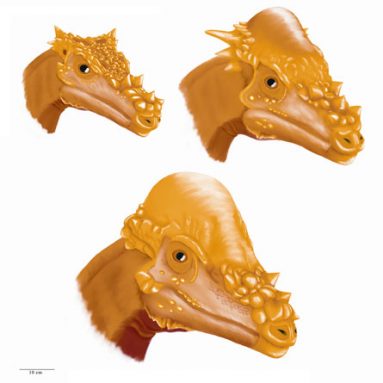The paleontologist and the three dinosaurs
Skulls thought to be from three different dinosaurs may actually be from the same dino type at three different ages
Share this:
- Share via email (Opens in new window) Email
- Click to share on Facebook (Opens in new window) Facebook
- Click to share on X (Opens in new window) X
- Click to share on Pinterest (Opens in new window) Pinterest
- Click to share on Reddit (Opens in new window) Reddit
- Share to Google Classroom (Opens in new window) Google Classroom
- Click to print (Opens in new window) Print
 |
|
Three different dinosaurs — Dracorex, Stygimoloch and Pachycephalosaurus (clockwise from top left) — might actually be the juvenile, teen and adult of the same dino. |
| Holly Woodward |
A new twist in an old story about dinosaur bones sounds like a fairy tale for fossil fans: Once upon a time, scientists discovered three different dinosaur skulls in the northern United States. The first skull, found in 1931, was large and round. The second, found in 1983, was smaller and narrower—and had spikes sticking out of the back of its head. The third, which had horns on its snout, was found in 2006. This was the smallest skull of all.
Like all good tales, there’s a surprise at the end of this dino story. Scientists have long thought that these three skulls belonged to three different kinds of dinosaurs. But don’t tell that to Jack Horner, a paleontologist at the Museum of the Rockies in Bozeman, Montana. He says that’s probably not true. According to a new study by Horner and his team, the three skulls are more likely from a kid, teenager and adult of the same kind of dinosaur.
All three dinosaurs lived about 65 million years ago in an area now known as Hell Creek, in Montana and South Dakota. The scientific name for the first, largest-skulled dinosaur is Pachycephalosaurus wyomingensis. The second, with the spikes, is Stygimoloch spinifer, which means “horned devil from the river of death.” The third dinosaur takes its name from the world of Harry Potter—it is called Dracorex hogwartsia, which means “dragon king from Hogwarts.”
Horner began to suspect the truth about the three skulls after he heard about studies of duck-billed dinosaurs. In those studies, scientists found that a set of skulls that all looked different were found to be from different ages of the same type of dinosaur. To investigate his hunch, Horner and his team studied bone fragments from the three thickheaded skulls.
“It’s real easy to tell young bone from old bone,” Horner told Science News. Young bones are still growing and need a lot of blood flow, so they have more tunnels and passageways for blood vessels. (With all the tunnels and holes, the insides of these bones look a little like sponges.) Older bones are more dense, which means they look more solid and don’t have as many tunnels and passageways going through.
Horner and his team found that the biggest skull had few tunnels in it, which suggests the skull comes from an adult dinosaur. The two smaller skulls both had many tunnels, which suggests that those dinosaurs were younger when they died.
The scientists found other evidence: They took CAT scans, or special pictures similar to X-rays, of the smaller skulls and saw that the bones had not yet grown fully together, as they do in adults.
Horner’s method of studying the bone structure of skulls is a new way to look at dinosaurs. “In the past, people have been very reluctant to cut open skulls and look at their bone histology,” he told Science News. “This will show them you can get an awful lot of information from doing that.”
The Museum of the Rockies, where Horner works, has the largest collection of dinosaur bones in the world—as well as the largest T. rex skull ever found. With his new discovery, Horner accidentally made a lot of work for himself.
“I made a brand new dinosaur hall at the museum three years ago, and now I have to change it,” he said. He may also have made a lot more work for other scientists. Future studies may reveal that some other dinosaur bones also came from the same type of dinosaur at different ages, rather than from different types of dinosaurs.
POWER WORDS (Adapted from Yahoo! Kids Dictionary and Britannica.com)
paleontology The study of the forms of life existing in prehistoric or geologic times, as represented by the fossils of plants, animals, and other organisms.
CAT scan Short for “computerized axial tomography,” a CAT scan is a special kind of x-ray that produces cross-sectional views of the inside of a bone or body.
Pachycephalosaurus Large and unusual “thick-headed” dinosaurs which grew to be about 5 m (16 feet) long. They had strong hind limbs and much less developed forelimbs. Their most distinctive feature is a high, domelike skull formed by a thick mass of solid bone grown over the tiny brain.
histology The anatomical study of the microscopic structure of animal and plant tissues. The microscopic structure of tissue.
Going Deeper:







